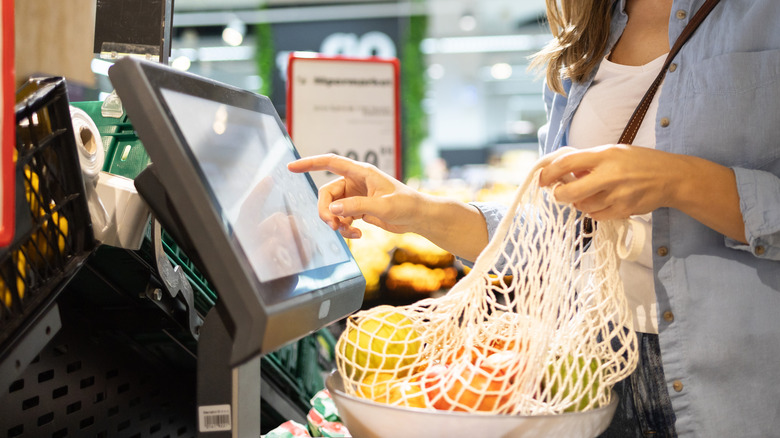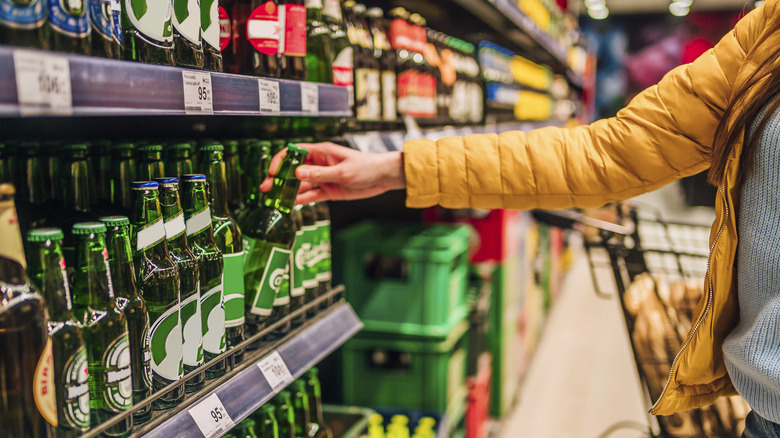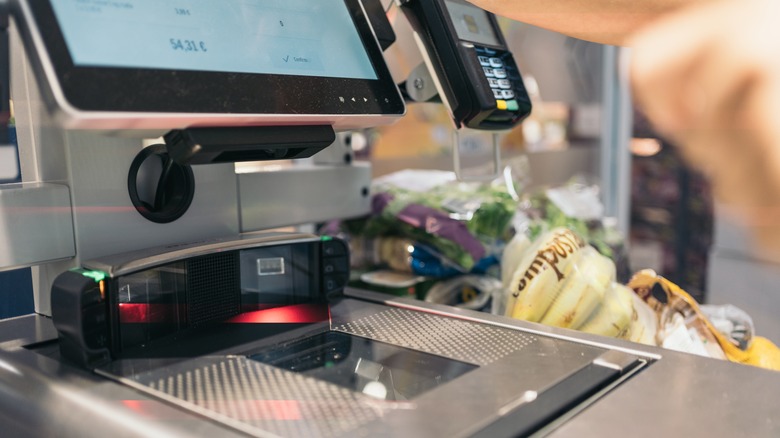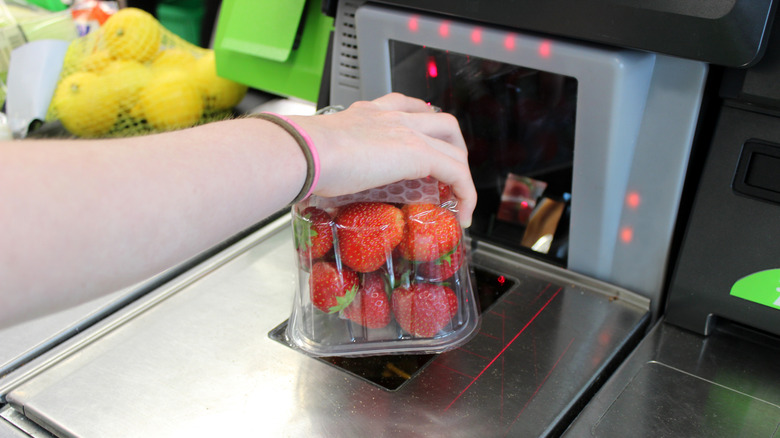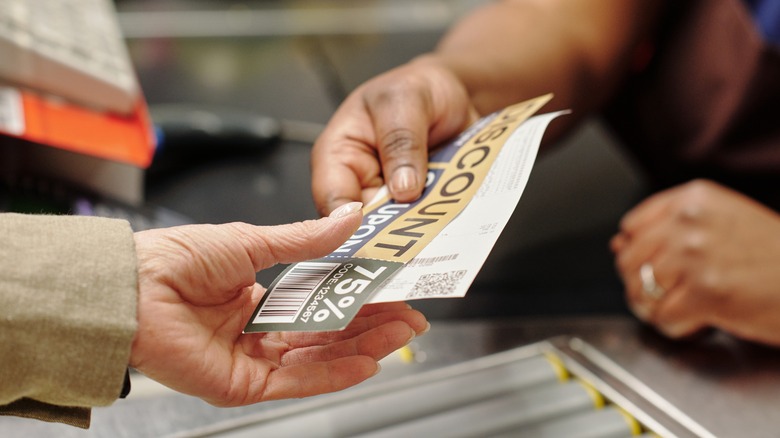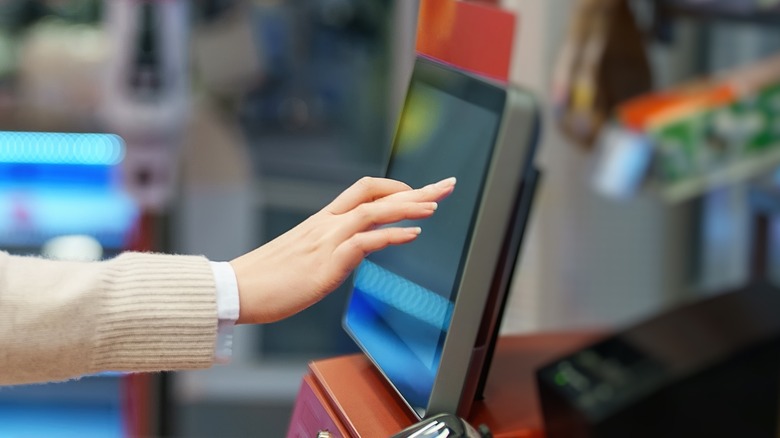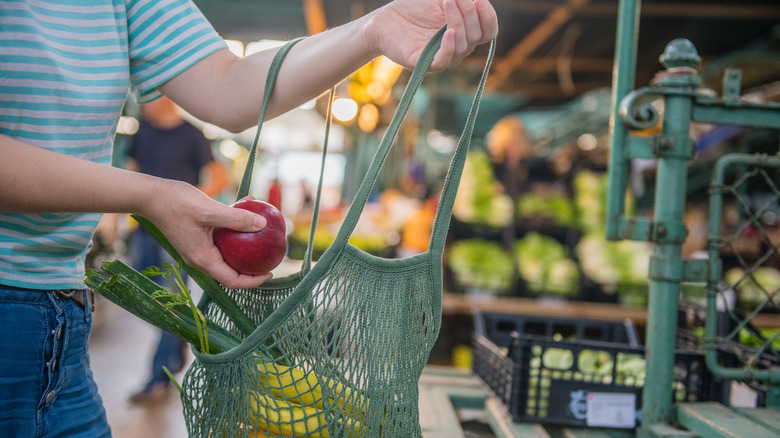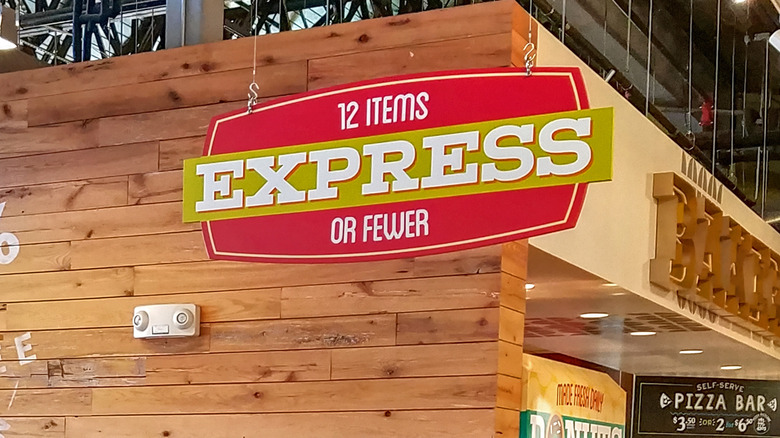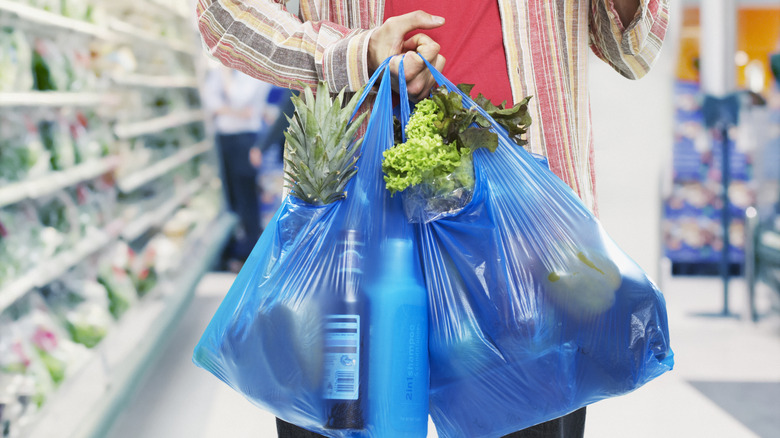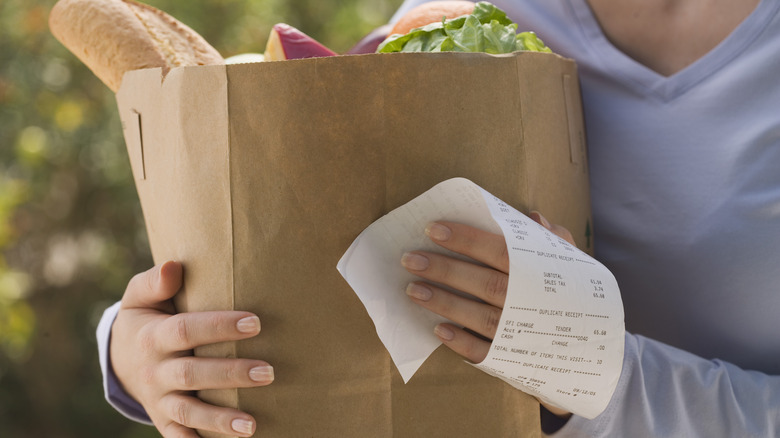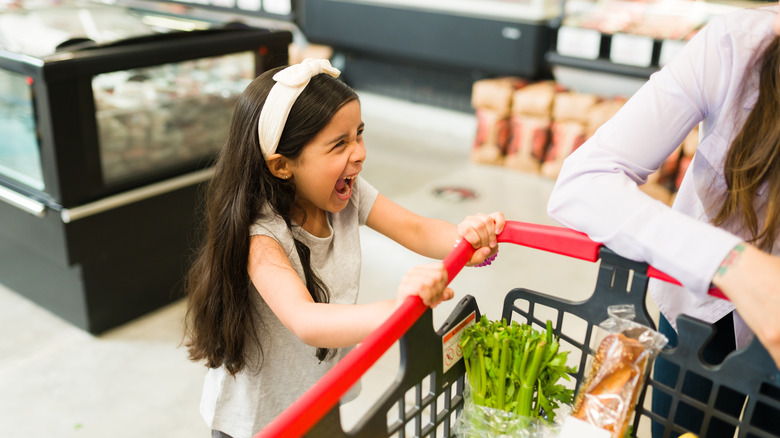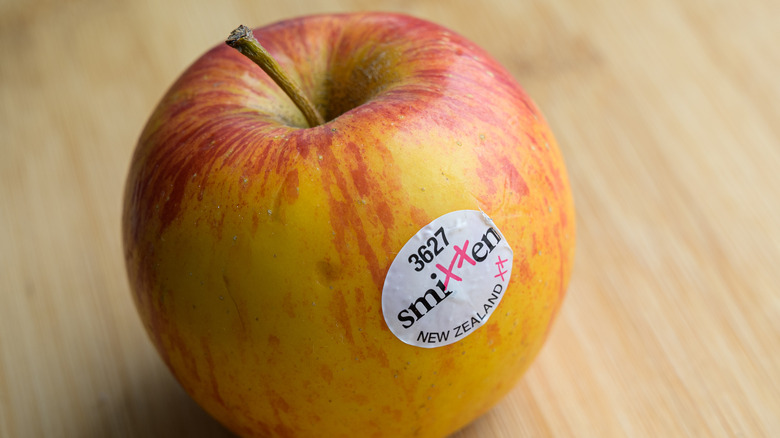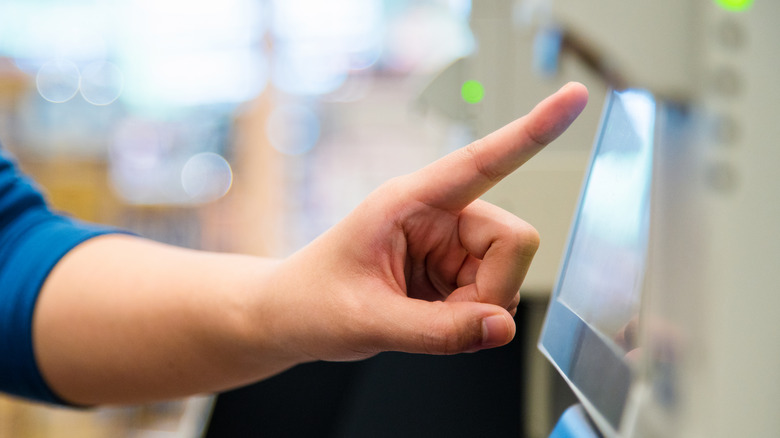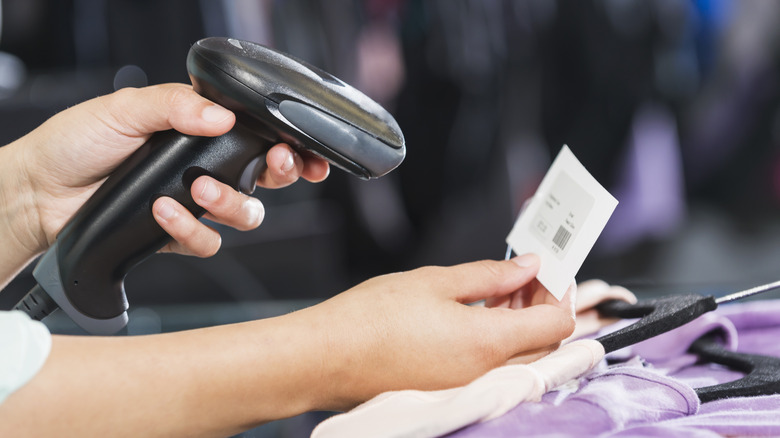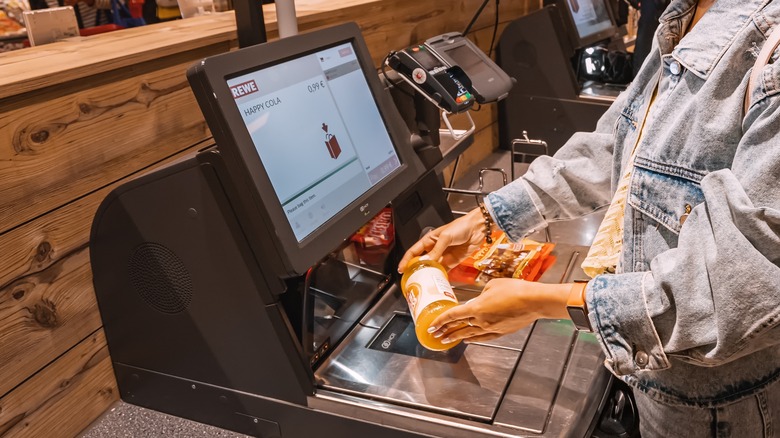Etiquette Rules Everyone Needs For Grocery Store Self-Checkouts
Much like those receptacles that give you the option to dispose of waste through either recycling, composting, or garbage (and you just know you're choosing the wrong one), the self-checkout line at the grocery store is seemingly designed to be more confusing than it is helpful. Even if you've used one of these stations before, they can sometimes be overwhelming.
To be fair, there are a lot of questions involved: How many items are you allowed to take through? Is it okay to buy broccoli (or really any produce) if you haven't memorized an entire Rolodex of PLU codes? And why is the robot voice that tells you to "place your item in the bagging area" always so pushy?
The good news is that most self-checkout kiosks do have clearly printed rules right at the entrance. If you look for them, you'll quickly be able to identify the basics. Add in a few simple etiquette tips to ensure you don't lose your humanity in the process, and you'll be a pro in no time. The future is here — it's time to shop smarter and figure out how to efficiently use the grocery store self-checkout.
Don't buy booze, probably
It's no secret that you have to be at least 21 years old to buy alcohol in the U.S. Even so, each state has its own sales approach to alcohol, so don't assume that one store will work the same as another, even if they're part of the same chain.
For instance, some stores mandate that a person must be carded if they appear to be under a specific age. This can range anywhere from 21 to 91 — in Oregon, for example, you'll get carded if you appear to be younger than 26. The state also refuses grocery stores the right to sell hard alcohol, so you'll have to hit up a liquor or convenience store for that. California has banned the purchase of booze through self-service kiosks, while other states allow customers to buy alcohol in drive-thrus.
Ideally, you should leave alcohol behind at the self-checkout stand; even if you know the rules, you'll still need to be carded, which can hold up the line. If you're going to take your bottle of wine through, remember that knowing the rules is your responsibility. Research the store's policies or go through the traditional checkout line and ask your questions first. That way, you can head to the self-service kiosks with confidence the next time you visit. (Additionally, don't try to buy cigarettes — it won't work and will only slow things down further.)
Clean up after yourself
Self-checkout has, well, a checkered reputation. A series of 2024 studies published in the Journal of Business Research has demonstrated that customers show higher loyalty to stores where they're served by a cashier rather than those where they use a self-service kiosk. The authors do note, however, "When customers are primed to think of the self-checkout experience as rewarding and accomplishing, those who use self-checkout demonstrate the same level of customer loyalty as those who use regular checkout."
Unfortunately for introverts who really, really appreciate these stations' lack of small talk, many stores have started removing self-checkout lanes, citing theft, longer wait times than traditional lines, and difficulty monitoring the checkout process. Customer complaints also factor heavily into this equation, as technological systems often break down or make mistakes.
Here's the bottom line: If you value self-checkout lanes, then it's best to ensure that the customers around you have the best possible experience. If you spill a bulk good or get water on the scale from your un-bagged broccoli, make sure you wipe it up. This will keep everything clean and help prevent food safety issues. Many stores have rags or paper towels on hand for this reason (though you can also bring your own). Leave the bags tidy, toss out any receipts you don't want, and generally leave the register in the condition you'd like to find it.
Don't look for barcodes
If you've ever stood helplessly at a self-checkout register trying (unsuccessfully) to scan a box of cereal over and over again, then you know the pain of a barcode that just doesn't want to work. Many shoppers, however, put too much stock in getting the barcode angle "right," when that not only holds up the line but may be the very factor causing all of their woes.
Different scanners are designed to read barcodes from different angles, so depending on the system your store uses, a strategy that works there might not work elsewhere. Rather than trying to perfectly align your item with the reader, simply grab your object and wave it in front of the scanner. Most systems have readers at two different angles, so this strategy is likely to catch at least one of them. If you still don't hear the "beep," try reversing the object's position in your hand. This can really save time, as opposed to checking all six sides of that cereal box.
Pass on the coupons
Brought coupons? Don't use the self-checkout kiosk unless you really know what you're doing. While it's perfectly possible to use coupons at these stations in most stores, your chances of holding up the line are significant. If you're a dedicated bargain hunter determined to use the self-checkout lane, or if you enjoy going to stores that happen to have limited cashiers, make sure you do it right.
If you're going to use paper, clip your coupons ahead of time. Don't bring an entire pamphlet and flip through it during the after-work rush. Better yet, keep your coupons organized on your phone so you can pull them up when the time comes. Most grocery chains now have a native app that makes this pretty easy. Some self-checkout kiosks have slots into which you can feed paper coupons, while nearly all of them will let you input discounts (whether through barcodes or Q.R. codes) from both phones and paper using the main scanner.
Input your loyalty number first
Whether you're using a phone number or scanning a loyalty card, do so at the beginning of the self-checkout process. Some registers will make you scan an item first to prove you're actually there to buy something; why you would need to input a loyalty number otherwise is unclear, but nevertheless, this is the case at some stores (including the one yours truly patronizes thrice a week). If this is true for your preferred store, simply scan one item, place it in the bagging area, and then swipe your loyalty card.
This accomplishes a few things. For one, it means you won't forget to do so and hold up the line later when you try to get a clerk to help you after it's too late. For another, a lot of self-checkout kiosks remember your shopping history and will show you a customized list of options when you use them to look something up. This can save you time and keep the line moving quickly. Plus, it means you'll get your receipt emailed to you, so you can skip waiting for it at the kiosk.
Let the machine know that you brought your own bags
Some self-checkout registers require that you alert them if you brought your own bags; otherwise, the robot voice will not be pleased when you place an unknown object (your bags) in the bagging area without scanning it first. These scales are usually quite sensitive and can detect even the few ounces of a reusable bag. Although this might not seem like much, consider that a few ounces of saffron or pine nuts costs quite a bit, so this standard isn't totally unreasonable.
The best advice here is not to rush through the options at the beginning. Although many people justifiably become annoyed with the rigmarole required just to scan a few packages of instant ramen, those options are there for a reason. Read them carefully to make sure you select the correct options for your shopping trip, including whether or not you brought your own bags with you. The machine will then weigh your bags ahead of time to make sure you're not cheating.
Pro tip: Don't make the mistake of laying your bags flat on the bottom of your cart as you come into the store. Instead, place them on the bottom rack or fold them and place them in the child seat area (assuming no child is sitting there). That way, you can easily remove and weigh them as soon as you arrive at checkout.
Look for Express Lane signs
Many self-checkout registers don't specify the maximum number of items you can purchase; many, however, do. For instance, in a March 2024 press release, Target announced that it's implementing a 10-item self-checkout limit at most of its 2,000 stores nationwide. According to the chain, traditional checkout lanes are the appropriate choice for shoppers who need additional customer service or have more than 10 items (or, as Corporate carefully added, for those who just love connecting with Target staff).
In general, if a store's self-checkout kiosks have restrictions of any kind, the store will state it clearly at the lane's entrance. In addition to an item limit, such restrictions may include the types of items you can buy (e.g., no alcohol) or times the lane is closed. As with a restaurant, don't head to self-checkout moments before the clerk shuts it down. Additionally, if the station has an item limit, it's rude to exceed it, just as with a manned checkout.
Limit grocery items to about four bags
Many self-checkout kiosks don't have an item limit, and barring any signs claiming otherwise, it's probably fine to go through with a full cart. Indeed, many stores install self-service lanes to limit staffing, so they're happy to have you scan big loads yourself. It's working, too — in 2021, a full 30% of transactions took place in a self-checkout capacity, according to data from The Food Industry Association.
Despite this popularity, proposed rules in places like California would limit all lanes in the state to 10 items and require one clerk for every two terminals. This means shoppers may need to adjust to self-checkout as an express-only option, at least in some states. In others, even if you're allowed to ring up an unlimited number of items, there's another stumbling block to consider: the bagging area.
There's often (but not always) a scale in this area that weighs your items as you scan them to make sure you're buying what you claim. Some stores require that you put all of your groceries there before loading any back into your cart. In these cases, you only have about four bags' worth of room, so limit your shopping accordingly. Otherwise, you may have to do multiple transactions, which will hold up the line.
If the store is busy, consider limiting your items further
When your store of choice is bustling, self-checkout is a convenient way for shoppers to snatch their items and go without having to wait for someone else to complete their weekly family shop. If there's an express lane, this is less of an obligation because there's somewhere else they can go; however, if self-checkout is the only way for them to grab and go, you might want to cede territory.
As discussed, you don't have to use a manned lane if the store hasn't posted an item limit, but it's still a nice way to help your fellow shoppers. If you're definitely going through self-checkout no matter what, consider letting someone with only an item or two go ahead of you. If nothing else, you will have performed your good deed for the day and can weather any dirty looks with equanimity.
Don't take your kids through self-checkout
If you have young children, consider heading to a manned checkout line. That way, you can wrangle them while the cashier scans your items. If you have older kids who can actually help because they know what they're doing, that's fine. Otherwise, you risk the wrath of the public.
At least one viral TikTok from 2024 has featured a proud parent teaching their barely walking child how to use the self-checkout scanner, claiming that the experience has learning potential. The public's take on this, however, is that you should save such teaching moments for low-traffic times if you're going to leverage them at all. A better way to instill self-efficacy in children is to let them help you shop, then teach them patience in the checkout lines while you let a trained professional look up the price of beets. At the very least, this will save you some dirty looks.
Use PLU codes, but know your limits
The PLU (or price look-up) code is there for a reason: So that you can tell the system what you're buying without having to painstakingly type it in. If your produce comes with a PLU, go ahead and enter it rather than looking up the item by name. It's a lot easier to type a five-digit code than it is to type in "Savoy cabbage."
That said, make sure you respect your own limitations because, let's face it, not everyone is the Flash. If you already know you're not super tech-savvy, then try using the self-checkout during slower times. Avoid weekends and evenings while you learn the system so you don't hold up the line. It's okay to have limits, but it's less okay to expose others to them when they're just trying to go about their busy lives.
This might be a good time to bring a shopping buddy on your trips. If you have a spouse, child, or grandchild who's down to accompany you while learning, great. Everyone needs a leg up at one time or another, so feel free to lean on your community. Last but not least, if you're unsure what you're doing and need some assistance, come at a less busy time (midday on Thursday, for example) and ask the attendant to walk you through the process.
Obey the machine
Sure, it's annoying that the robot voice makes you put your giant bag of potting soil that definitely belongs in your cart on the platform until you're done ringing yourself up, but you're already there. Getting fussy about it only holds up the line, so follow its instructions and select the right option.
Many machines will give you an option to clue them in that you're going to put the object back into your cart. Press "skip bagging" (if it's available) so you can put that big box of sodas right back where you got it before proceeding. If you can't, c'est la vie.
If you make a mistake and the machine calls for an attendant, don't make any sudden moves. Just sit tight and wait for your human helper to come and sort out the problem, as continuing will only aggravate the robot voice and further stall the line. As you get better at using self-checkout, this will happen less and less, or you'll figure out how to deal with the situation yourself. Likely both.
Scan items in the order you'll bag them
Nothing is more annoying than waiting for someone to lovingly arrange their groceries in bags. Instead of making those behind you cool their heels, scan your heaviest items first, such as canned foods, and use them to line the bottoms of your grocery bags. Then, put lighter objects and veggies on top, scanning them in the order you plan to bag them.
Repeat this process with the rest of your items, grouping like items together. For instance, put frozen goods like vanilla ice cream and frozen peas in one bag, as this will keep everything cold if you can't get them into the freezer right away. You might also consider putting food from the butcher in one bag, like when you're buying salmon and choosing ground beef. Some people like to open and arrange the number of bags they think they'll need right at the outset so that all they have to do for the rest of the transaction is bag.
To make this process smoother, try arranging your shopping cart so that this is possible. Rather than throwing everything in willy-nilly, designate a spot in your cart for light or fragile items and a spot for heavy, boxy, sturdy items. That way, when you're scanning and bagging, you can pull from these areas as needed.
Remember to scan all of your items
Most people don't intend to steal, but it's way easier in a self-checkout lane than it is when a cashier is ringing up all your items for you. You may leave items on your cart's bottom rack, accidentally type in the code for an apple and scan a mango instead, or ring up three bars of chocolate instead of four. Be careful, not only because it's the right thing to do, but because correcting a mistake takes time out of someone else's day. It's bad etiquette to make other people wait around while an assistant enters their special code or scans their badge, so try to keep your eyes on the prize, even if you're tempted to scan on autopilot.
Additionally, product loss is one of the main reasons that many stores are rethinking self-checkout lanes, regardless of whether or not the crime is intentional. If you value self-checkouts and want to keep them around, then helping prevent product loss is one of the most helpful steps you can take.
